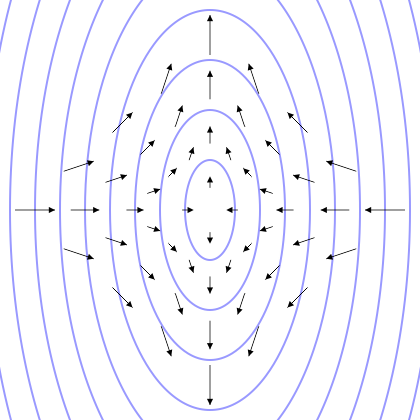|
OJ287
OJ 287 is a BL Lac object 4 billion light-years from Earth that has produced quasi-periodic optical outbursts going back approximately 120 years, as first apparent on photographic plates from 1891. Seen on photographic plates since at least 1887, it was first detected at radio wavelengths during the course of the Ohio Sky Survey. It is a supermassive black hole binary (SMBHB). The intrinsic brightness of the flashes corresponds to over a trillion times the Sun's luminosity, greater than the entire Milky Way galaxy's light output. Characteristics Given the variability in the SMBHB's bursts and properties, multiple models have been proposed to account for these flashes. The initial model estimates the mass of the primary black hole to be approximately 18.35 billion solar masses and the secondary black hole around 150 million solar masses. More recent models estimate that the central supermassive black hole has a mass of 100 million solar masses, much less than previous estimation ... [...More Info...] [...Related Items...] OR: [Wikipedia] [Google] [Baidu] |
Supermassive Black Holes
A supermassive black hole (SMBH or sometimes SBH) is the largest type of black hole, with its mass being on the order of hundreds of thousands, or millions to billions, of times the mass of the Sun (). Black holes are a class of astronomical objects that have undergone gravitational collapse, leaving behind spheroidal regions of space from which nothing can escape, including light. Observational evidence indicates that almost every large galaxy has a supermassive black hole at its center. For example, the Milky Way galaxy has a supermassive black hole at its center, corresponding to the radio source Sagittarius A*. Accretion of interstellar gas onto supermassive black holes is the process responsible for powering active galactic nuclei (AGNs) and quasars. Two supermassive black holes have been directly imaged by the Event Horizon Telescope: the black hole in the giant elliptical galaxy Messier 87 and the black hole at the Milky Way's center (Sagittarius A*). Description ... [...More Info...] [...Related Items...] OR: [Wikipedia] [Google] [Baidu] |
Binary Black Hole
A binary black hole (BBH), or black hole binary, is an astronomical object consisting of two black holes in close orbit around each other. Like black holes themselves, binary black holes are often divided into binary stellar black holes, formed either as remnants of high-mass binary star systems or by stellar dynamics, dynamic processes and mutual capture; and binary supermassive black holes, believed to be a result of galactic mergers. For many years, proving the existence of binary black holes was made difficult because of the nature of black holes themselves and the limited means of detection available. However, in the event that a pair of black holes were to merge, an immense amount of energy should be given off as gravitational waves, with distinctive waveforms that can be calculated using general relativity. Therefore, during the late 20th and early 21st century, binary black holes became of great interest scientifically as a potential source of such waves and a means by whi ... [...More Info...] [...Related Items...] OR: [Wikipedia] [Google] [Baidu] |
BL Lac Object
A BL Lacertae object or BL Lac object is a type of active galactic nucleus (AGN) or a galaxy with such an AGN, named after its prototype, BL Lacertae. In contrast to other types of active galactic nuclei, BL Lacs are characterized by rapid and large-amplitude flux variability and significant optical polarization. Because of these properties, the prototype of the class (BL Lac) was originally thought to be a variable star. When compared to the more luminous active nuclei (quasars) with strong emission lines, BL Lac objects have spectra dominated by a relatively featureless non-thermal emission continuum over the entire electromagnetic range. This lack of spectral lines historically hindered identification of the nature and distance of such objects. In the unified scheme of radio-loud active galactic nuclei, the observed nuclear phenomenology of BL Lacs is interpreted as being due to the effects of the relativistic jet closely aligned to the line of sight of the observer. BL Lacs a ... [...More Info...] [...Related Items...] OR: [Wikipedia] [Google] [Baidu] |
Accretion Disc
An accretion disk is a structure (often a circumstellar disk) formed by diffuse material in orbital motion around a massive central body. The central body is most frequently a star. Friction, uneven irradiance, magnetohydrodynamic effects, and other forces induce instabilities causing orbiting material in the disk to spiral inward toward the central body. Gravitational and frictional forces compress and raise the temperature of the material, causing the emission of electromagnetic radiation. The frequency range of that radiation depends on the central object's mass. Accretion disks of young stars and protostars radiate in the infrared; those around neutron stars and black holes in the X-ray part of the spectrum. The study of oscillation modes in accretion disks is referred to as diskoseismology. Manifestations Accretion disks are a ubiquitous phenomenon in astrophysics; active galactic nuclei, protoplanetary disks, and gamma ray bursts all involve accretion disks. These disks ... [...More Info...] [...Related Items...] OR: [Wikipedia] [Google] [Baidu] |
Quasars
A quasar ( ) is an extremely Luminosity, luminous active galactic nucleus (AGN). It is sometimes known as a quasi-stellar object, abbreviated QSO. The emission from an AGN is powered by accretion onto a supermassive black hole with a mass ranging from millions to tens of billions of solar masses, surrounded by a gaseous Accretion disk, accretion disc. Gas in the disc falling towards the black hole heats up and releases energy in the form of electromagnetic radiation. The radiant energy of quasars is enormous; the most powerful quasars have luminosity, luminosities thousands of times greater than that of a galaxy such as the Milky Way. Quasars are usually categorized as a subclass of the more general category of AGN. The redshifts of quasars are of Expansion of the universe, cosmological origin. The term originated as a Contraction (grammar), contraction of "quasi-stellar ''[star-like]'' radio source"—because they were first identified during the 1950s as sources of radio-wave ... [...More Info...] [...Related Items...] OR: [Wikipedia] [Google] [Baidu] |
BL Lacertae Objects
A BL Lacertae object or BL Lac object is a type of active galactic nucleus (AGN) or a galaxy with such an AGN, named after its prototype, BL Lacertae. In contrast to other types of active galactic nuclei, BL Lacs are characterized by rapid and large-amplitude flux variability and significant optical polarization. Because of these properties, the prototype of the class (BL Lac) was originally thought to be a variable star. When compared to the more luminous active nuclei (quasars) with strong emission lines, BL Lac objects have spectra dominated by a relatively featureless non-thermal emission continuum over the entire electromagnetic range. This lack of spectral lines historically hindered identification of the nature and distance of such objects. In the unified scheme of radio-loud active galactic nuclei, the observed nuclear phenomenology of BL Lacs is interpreted as being due to the effects of the relativistic jet closely aligned to the line of sight of the observer. BL Lacs a ... [...More Info...] [...Related Items...] OR: [Wikipedia] [Google] [Baidu] |
Calar Alto Observatory
The Calar Alto Observatory (Centro Astronómico Hispano en Andalucía or "Spanish Astronomical Centre in Andalusia") is an astronomical observatory located in Almería province in Spain on Calar Alto, a mountain in the Sierra de Los Filabres subrange of the Sierra Nevada. Until 2018, Calar Alto was owned and operated jointly by the German Max Planck Institute for Astronomy in Heidelberg, and the Spanish Institute of Astrophysics of Andalusia (IAA-CSIC) in Granada. It was named the "German–Spanish Astronomical Centre" (in Spanish, Centro Astronómico Hispano-Alemán (CAHA); in German, Deutsch-Spanisches Astronomisches Zentrum). In 2019, the Council of Andalusia takes over the German partner, sharing the observatory with the Spanish National Research Council through its head institute, IAA-CSIC. Calar Alto telescopes are used for a broad range of observations, from objects in the Solar System to cosmology (thAlhambraand CALIFA surveys), including the search for exoplane ... [...More Info...] [...Related Items...] OR: [Wikipedia] [Google] [Baidu] |
Gravitational Radiation
Gravitational waves are oscillations of the gravitational field that travel through space at the speed of light; they are generated by the relative motion of gravitating masses. They were proposed by Oliver Heaviside in 1893 and then later by Henri Poincaré in 1905 as the gravitational equivalent of electromagnetic waves. In 1916, Albert Einstein demonstrated that gravitational waves result from his general theory of relativity as ripples in spacetime. Gravitational waves transport energy as gravitational radiation, a form of radiant energy similar to electromagnetic radiation. Newton's law of universal gravitation, part of classical mechanics, does not provide for their existence, instead asserting that gravity has instantaneous effect everywhere. Gravitational waves therefore stand as an important relativistic phenomenon that is absent from Newtonian physics. Gravitational-wave astronomy has the advantage that, unlike electromagnetic radiation, gravitational waves are no ... [...More Info...] [...Related Items...] OR: [Wikipedia] [Google] [Baidu] |
Kerr Black Hole
The Kerr metric or Kerr geometry describes the geometry of empty spacetime around a rotating uncharged axially symmetric black hole with a quasispherical event horizon. The Kerr metric is an exact solution of the Einstein field equations of general relativity; these equations are highly non-linear, which makes exact solutions very difficult to find. Overview The Kerr metric is a generalization to a rotating body of the Schwarzschild metric, discovered by Karl Schwarzschild in 1915, which described the geometry of spacetime around an uncharged, spherically symmetric, and non-rotating body. The corresponding solution for a ''charged'', spherical, non-rotating body, the Reissner–Nordström metric, was discovered soon afterwards (1916–1918). However, the exact solution for an uncharged, ''rotating'' black hole, the Kerr metric, remained unsolved until 1963, when it was discovered by Roy Kerr.Melia, Fulvio (2009). "Cracking the Einstein code: relativity and the birth of black ... [...More Info...] [...Related Items...] OR: [Wikipedia] [Google] [Baidu] |
Black Hole Spin Parameter
A black hole is a massive, compact astronomical object so dense that its gravity prevents anything from escaping, even light. Albert Einstein's theory of general relativity predicts that a sufficiently compact mass will form a black hole. The boundary of no escape is called the event horizon. A black hole has a great effect on the fate and circumstances of an object crossing it, but has no locally detectable features according to general relativity. In many ways, a black hole acts like an ideal black body, as it reflects no light. Quantum field theory in curved spacetime predicts that event horizons emit Hawking radiation, with the same spectrum as a black body of a temperature inversely proportional to its mass. This temperature is of the order of billionths of a kelvin for stellar black holes, making it essentially impossible to observe directly. Objects whose gravitational fields are too strong for light to escape were first considered in the 18th century by John Mic ... [...More Info...] [...Related Items...] OR: [Wikipedia] [Google] [Baidu] |
Apsis
An apsis (; ) is the farthest or nearest point in the orbit of a planetary body about its primary body. The line of apsides (also called apse line, or major axis of the orbit) is the line connecting the two extreme values. Apsides pertaining to orbits around different bodies have distinct names to differentiate themselves from other apsides. Apsides pertaining to geocentric orbits, orbits around the Earth, are at the farthest point called the ''apogee'', and at the nearest point the ''perigee'', like with orbits of satellites and the Moon around Earth. Apsides pertaining to orbits around the Sun are named ''aphelion'' for the farthest and ''perihelion'' for the nearest point in a heliocentric orbit. Earth's two apsides are the farthest point, ''aphelion'', and the nearest point, ''perihelion'', of its orbit around the host Sun. The terms ''aphelion'' and ''perihelion'' apply in the same way to the orbits of Jupiter and the other planets, the comets, and the asteroids of t ... [...More Info...] [...Related Items...] OR: [Wikipedia] [Google] [Baidu] |





